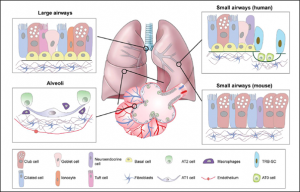
Chinese Medical Journal Pulmonary and Critical Care Medicine Study Explores Alveolar Repair Mechanisms in Lung Disease
Researchers shed light on the role of type II cells in the regeneration and repairing of alveoli epithelium
BEIJING, CHINA, September 2, 2024 /EINPresswire.com/ -- Type II cells (AT2) in the lung’s air sacs or alveoli repair damage from inhaled toxins and particulates. In a new study, researchers from the University of Illinois elucidate the various molecular mechanisms and intercellular interactions that facilitate the repairing function of AT2. They provide detailed insights on AT2s, the research techniques that precipitated these discoveries, and how they may lead to new treatments for lung diseases.The lungs’ air sacs, called alveoli, are the site of gas exchange necessary for respiration. The topmost layer of the alveolar sac, called the epithelium, has cells that are exposed to particulates and toxins in air breathed in during respiration. Therefore, this layer is continuously subject to environmental insult and consequential damage. Of the two types of cells that make up the alveolar epithelium - type 1 cells (AT1) and type II cells (AT2), AT1 composes the large majority of alveolar surface cells that interact with inhaled air. AT2 repairs damaged epithelium by acting as stem cells and differentiating into AT1 cells.
In a recent study published in the Chinese Medical Journal Pulmonary and Critical Care Medicine on March 2024, researchers Dr. Jilei Zhang and Dr. Yuru Liu detail how AT2 cells play a crucial role in the renewal and regenerative repairing of the alveolar epithelium. The study highlights the recent advancements in alveolar repair research, elucidating the underlying mechanisms involved.
The process of cell turnover in the alveoli is different from that in parts of the body constantly exposed to the environment, such as the skin, which contains dedicated stem cells. Cell turnover rate is also much slower in the alveoli.
“During homeostasis, only small subsets of AT2 cells are intermittently activated for either self-renewal or differentiation into AT1 cells, thus replacing damaged or aged epithelium. However, following lung injury, there is a considerable surge in the activation of AT2 cells”, explains Dr. Liu, the lead researcher in the study.
One of the chief findings in recent research on alveolar repair is that AT2 cells are not all the same. Various AT2 subpopulations differ in their ability to undergo differentiation and repair the epithelium. Moreover, a small subpopulation of AT2 cells disproportionately performs most of the epithelial regeneration function.
“We identified a small sub-population of AT2 cells, constituting approximately 3% of the total AT2 population, which expressed elevated levels of the hyaluronan receptor CD44, and are located primarily at these perivascular ‘hot spots’. These CD44-high AT2s exhibited higher proliferation rates and increased potential for differentiation into AT1 cells, as well as for generating larger three-dimensional organoids when compared to bulk AT2 cells”, Dr. Liu notes.
Cells in the alveoli, besides AT1 and AT2 cells, engage in continuous interactions with AT2 cells. In the article, the researchers explain the various molecular interactions of AT2 cells with endothelial cells, fibroblasts, and immune cells. These cells are responsible for collaboratively facilitating several vital functions of AT2s, and their molecular crosstalk with AT2 cells has potential implications for the treatment of several lung diseases.
“It is our aspiration that a deeper understanding of the fundamental cellular and molecular mechanisms underlying alveolar homeostasis and regeneration will open avenues for identifying novel therapeutic targets for conditions such as chronic obstructive pulmonary disease (COPD), fibrosis, coronavirus disease 2019 (COVID-19), and lung cancer”, explains Dr. Liu.
Techniques in molecular and cell biology and tools used for studying alveolar cells have advanced markedly in the last decade. These advances have contributed to many of the previously mentioned breakthroughs in studying alveolar epithelial cells. Notable advances in this regard include the establishment of mouse models for lung damage, genetic techniques that allow tracing the lineage of AT2 sub-populations, and 3D organoids for studying molecular interactions between AT2 cells and other types of cells in the microenvironment.
Moving forward, researchers note that single-cell RNA sequencing (scRNA-seq) has contributed significantly to the study of alveolar epithelial cells. In this context, Dr. Lie emphasizes “The advent of scRNA-seq has marked a watershed moment in understanding the intricate cellular interactions during lung injury and repair. This technology enables the identification of unique subsets of epithelial and niche cells throughout dynamic injury—repair processes.”
The authors hope that successful improvements in lab techniques and the establishment of more accurate models will improve our understanding of molecular processes involved in lung repair. In the long term, these advancements may also reveal innovative ways of tackling lung diseases and mitigating chronic diseases linked to impaired tissue regeneration.
***
Reference
Title of original paper: Epithelial stem cells and niches in lung alveolar regeneration and diseases
Journal: Chinese Medical Journal Pulmonary and Critical Care Medicine
DOI: 10.1016/j.pccm.2023.10.007
Peifang Wei
Chinese Medical Journal Pulmonary and Critical Care Medicine
+86 138 1092 3769
Weipeifang@cma.org.cn
Visit us on social media:
X
Distribution channels: Healthcare & Pharmaceuticals Industry, Science
Legal Disclaimer:
EIN Presswire provides this news content "as is" without warranty of any kind. We do not accept any responsibility or liability for the accuracy, content, images, videos, licenses, completeness, legality, or reliability of the information contained in this article. If you have any complaints or copyright issues related to this article, kindly contact the author above.
Submit your press release
